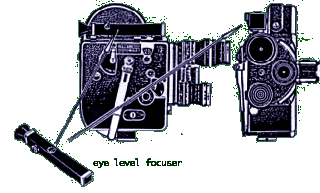1)
Kern-Paillard Yvar 1:2.8 f=75mm AR; Serial No. 223939
C mount lens with shade extension, both lens caps,
and leather case
2)
Wollensak Cine Raptar 1 inch f/1.9; Serial No. 721823
with no lens caps
Bolex
has always made high-quality, precision reflex cameras
that are perfect for students, animators, and other
professional filmmakers. This camera is loaded
with features:
-
through-the-lens
eye level focus
-
The
eye level focuser allows focussing through
the selected lens, whereby the image is projected
onto a ground glass plane for setting focus,
adjusting depth of field, etc. Once set, the
turret must be rotated into proper position
for actual filming, where the side mounted
parallax correcting viewfinder offers the
approximate view of the subject matter. (This
is not a reflex viewfinder)

-
three-lens
turret with folding lever accepts C-mount lenses
(also called 1-inch-mount lenses)--Switar and
others.
-
single-frame
actuation, for ANAMATION
-
single-frame
TIME EXPOSURES
(shutter stays open as long as trigger is depressed)
-
rugged
spring-windup motor
-
frame
rate from 8 to 64 fps
-
footage
and FRAME counters
-
diopter
correction for the viewfinder
ACCESSORIES
IN PHOTOS: take-up reel, trigger grip with its
own bag, two lenses, one with both caps,
one turret cap, and a leather lens case.
Resources
Filmmaking Study Aids
The
Bolex written and designed for the web by Joel Schlemowitz
Bolex History -- Serial Numbers and other
Info
A
very comprehensive look at the Bolex, from smallmovies:
Paillard S.A.: The Bolex H-16
Identifying Your Bolex by Clive Tobin
Identifying
a Bolex "H" Camera
Bolex
Manual in PDF format from Evergreen State College
in Washington State. 1.32 Megs. As of 3-27-02
http://www.evergreen.edu/media/pdf/Bolex_Manual.pdf
From Internet Filmmaker's FAQ
What 16mm cameras can be picked up cheaply?
Picking up a cheap 16mm camera can be
one of the best ways to start experimenting with filmmaking.
Whilst video is considerably easier to work with in
many ways, and a bit cheaper if you are looking at the
lower end of the scale, the fact remains that film is
the superior medium. It looks better, it is more accepted
at film festivals (although this is changing� slowly)
and let's face it, the feeling of seeing your work projected
at a decent quality makes a lot of the headaches resulting
from shooting film worth while.
Another option of course is to give your
baby that 'film look' by shooting on film, and getting
it telecined to video for an edit. This means you have
the nice look, but don't have to deal with the expense
of printing film (you can telecine straight from negative
to video). You can have all the advantages of editing
non-linear, and if your film turns out well you can
always go back and match the neg to your video cut and
get it printed.
Obviously any old 16mm camera you can
get your hands on cheap will do. You can pick them up
at jumble sales, camera shops, in newspaper classifieds
and sometimes from organizations (particularly government
departments) that often have a few old ones lying around
collecting dust. Regardless of camera, use camera shops
as the last resort as prices will often be inflated.
So which models are suited to broke wanna-be Spielbergs?
By far the most popular (and one of the
easiest/cheapest) items you can pick up is the Bolex
H-16. They are versatile and tough, the only downer
is they are clockwork. It's pretty easy to disconnect
the spring motor and attach an electric instead (and
some enterprising filmmakers have even built their own
motors). Unfortunately it's not really possible to shoot
sync sound with a H-16, but you can always be creative.
H-16s come in two varieties: Reflex (Rex) and non-Reflex.
The difference relates to how the view finder system
works. Older H-16s use a parallax view-finder which
is mounted on the side of the camera or rotated into
position using the lens turret. There will always be
a margin or error involved in non-Reflex cameras due
to the inability to look through the view-finder during
filming. Creativity and practice can minimise this.
Newer H-16s make use of the Reflex viewing system which
uses a prism to split the light entering the lens -
most of the light is delivered to the film stock, however
a small percentage is redirected to the view-finder.
The advantage is you can generally look through the
view-finder while filming. The downer is that you have
to adjust your exposures to correct for the slight degradation
of the light hitting the film surface. Reflex cameras
are by far the easier to work with, although you will
pay more for one of these. Look for early 'Rexes' (versions
1-3) as newer models will probably set you back at least
$US 2000. Non-reflex cameras range from about $US 200
upwards. There is an excellent website covering the
history/features of the H16 at http://www.city-net.com/~fodder/bolex/.